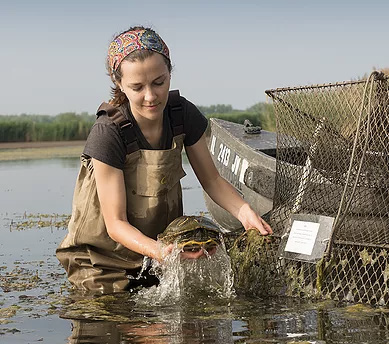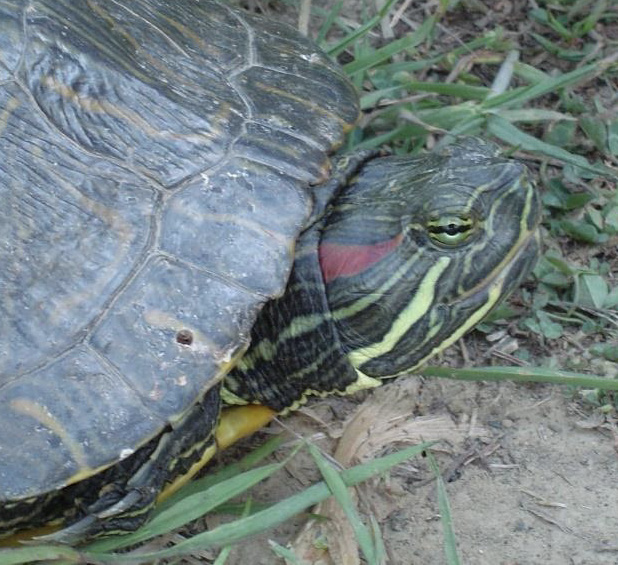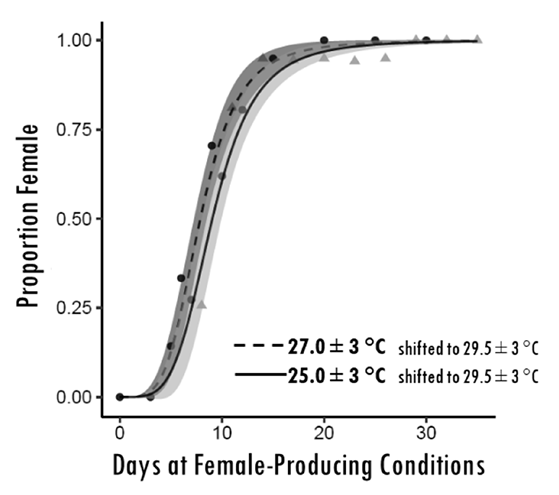Featured Scientist: Amanda Wilson Carter, PhD 2017, National Science Foundation Postdoctoral Research Fellow at the University of Tennessee (former PhD Candidate at Illinois State University, School of Biological Sciences)

Birthplace: New York City, NY
My Research: I study how animals are affected by changes in their environment.
Research Goals: I want to understand how changes in temperature affect animal physiology. I would like to be able to better predict how climate change will affect all types of animals.
Career Goals: I am currently working towards increasing the participation of underrepresented groups in science. My goal is to become a biology professor and researcher.
Hobbies: Traveling, playing with my dogs, and renovating my 1940’s bungalow.
Favorite Thing About Science: I love having the freedom to explore questions that I think are necessary and important. Throughout my schooling and career, I have also discovered a passion for mentoring students through independent projects in the lab. There is something very special about watching an undergraduate conduct their first study and transform into a confident and capable young investigator.
Organism of Study: I study many animals, but my PhD research focused on turtles, mainly the red-eared slider (Trachemys scripta). In my current position, I conduct research on dung beetles.

Field of Study: Eco-physiology | Climate Change | Plasticity | Development | Parental Effects
What is Eco-physiology? I broadly consider myself an eco-physiologist. I study how the physiology and behavior of animals are affected by their environment (mainly temperature).
Check Out My Original Paper: “The Devil is in the Details: Identifying Aspects of Temperature Variation that Underlie Sex Determination in Species with TSD”

Citation: A. W. Carter, R.T. Paitz,R. M Bowden, The Devil is in the Details: Identifying Aspects of Temperature Variation that Underlie Sex Determination in Species with TSD. Int Comp Biol. 59.4: 1081-1088 (2019).
Synopsis written by: Josselyn Gonzalez, M.S. (Anticipated Spring 2021), School of Biological Sciences, Illinois State University
Research at a Glance: The goal of this research was to help understand how animals respond to changes in temperature. To do this, Amanda used the red-eared slider turtle to study temperature-dependent sex determination (TSD). TSD is when the sex of an animal is affected by incubation temperatures. For example: red-eared slider turtles are typically male unless they experience warmer temperatures during development. If eggs are in warmer temperatures, even if it’s just a few days, then it will cause the turtles to develop as female instead of male.
It is important to be able to predict sex ratios, or the amount of male and female turtles, in nature. We want to know how future changes in temperature may affect animals, especially for those that are sensitive to temperature. Constant Temperature Equivalents (CTEs) are used to guess the number of female turtles produced when eggs are exposed to temperatures that go up and down, similar to how temperatures go up during the day and down during the night. They are very common in this type of research and have been used to predict sex ratios for many years. Recent research suggests that CTEs may not be the most accurate way to predict sex ratios in the wild.
Amanda’s goal was to determine if using the number of days at higher temperatures (female-producing temperatures) is a better way to predict the sex ratios than using CTEs. To test her question, Amanda used two groups of red-eared slider turtles (one from Illinois and one from Louisiana). She also looked to see if the turtles from Illinois and Louisiana responded similarly to temperature changes.
Amanda found that the best way to predict turtle sex ratios is to count the number of days that eggs are at higher temperatures. Using the CTE that eggs experience throughout incubation was not as accurate. She also found that turtles from Louisiana were more sensitive to temperature changes than turtles from Illinois.
Highlights: Amanda collected 183 turtle eggs and put them into different temperatures as they developed. Amanda chose temperatures that go up and down, similar to how temperatures go up during the day and down during the night. All of the eggs started at male-producing temperatures (25 ± 3°C) for 25 days. She used 22°C (71.6°F) for her nighttime temperature and 28°C (82.4°F) for her daytime temperature. Then, she switched all of her eggs to female-producing temperatures (29.5 ± 3°C). She used 26.5°C (79.7°F) for her nighttime temperature and 32.5°C (90.5°F) for her daytime temperature. The eggs stayed at female-producing temperatures for 8, 11, 14, 17, 20, 23, 26, 29, 32, or 35 days. Finally, all eggs were returned to male-producing temperatures (25 ± 3°C) until they hatched. Once turtles were 6 weeks old, Amanda determined the sex of each hatchling. The sex of each hatchling from this experiment was combined with the previous year’s data to help determine the best way to predict sex ratios.
What My Science Looks Like: In Figure 1, Amanda graphed the number of days that turtle eggs were at female-producing temperatures (x-axis) and the percent of turtle eggs that became female (y-axis).

For the experiment described in this paper, the male-producing temperatures used was 25 ± 3°C (dashed line). A similar experiment was done the year before but the male-producing temperature was 27 ± 3°C (solid lines). Both male-producing temperatures (dashed and solid lines) follow the same shape on this graph. Because of this, Amanda concluded that the number of days at female-producing temperatures is an accurate way to predict the number of female turtles produced.
In Figure 2, Amanda also graphed the CTE (x-axis) and the percent of turtle eggs that became females (y-axis).

In her first figure, Amanda was able to show that both male-producing temperatures (dashed and solid lines) resulted in the same sex ratios. But in this figure, she shows that they have different CTEs. Even though they had different CTEs, they resulted in the same amount of females. This means that CTEs are not a good way to predict sex ratios.
The Big Picture: Climate change is a growing threat, and it is important to understand how animals will respond to these changes. Amanda studies the effect of temperature on animals with TSD to help us predict how species will respond to future climates. This research also helps with our conservation efforts. The more we know about how the environment will affect species, the better we can help to curb these effects.
Decoding the Language:
Climate change: A change in global or regional climate patterns, often seen as major changes in temperature or precipitation.
Constant Temperature Equivalents (CTEs): A tool used to guess the number of females produced when eggs are exposed to temperatures that go up and down, similar to how temperatures go up during the day and down during the night. CTEs are calculated using formulas based on what you use as the nighttime and daytime temperature. For example, Amanda used male-producing temperatures of 25 ± 3°C. Using the CTE calculation, she would expect to get the same number of females as if she incubated the eggs using a constant temperature of 25.98°C.
Female/Male-producing temperatures: Female-producing temperatures are higher/ warmer temperatures that cause red-eared slider turtles to become female. Male-producing temperatures are lower/colder and cause these turtles to become male.
Incubation: The process of keeping an egg warm enough to develop until hatching. In the context of Amanda’s research, a male-producing incubation temperature is approximately 26°C and a female-producing temperature is approximately 31°C.
Physiology: A branch of biology that studies how different parts of the body carry out chemical and physical functions.
Sex ratio: A ratio that compares the number of males to the number of females in a given population. For example, a 1:1 ratio means the number of males and females is the same and that 50% were male and 50% were female. The sex ratio is important because without enough males and females, the population may decline because there will be fewer opportunities to mate and produce offspring.
Learn More:
Temperature-dependent sex determination
Synopsis edited by: Madison Rittinger, M.S. (Anticipated Fall 2021), and Anthony Breitenbach, PhD (Anticipated Spring 2021), School of Biological Sciences, Illinois State University.
Download this article here
Please take a survey to share your thoughts about the article!
